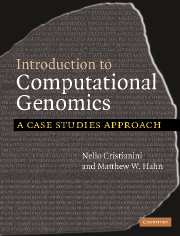Book contents
- Frontmatter
- Contents
- Preface
- Prologue: In praise of cells
- Chapter 1 The first look at a genome
- Chapter 2 All the sequence's men
- Chapter 3 All in the family
- Chapter 4 The boulevard of broken genes
- Chapter 5 Are Neanderthals among us?
- Chapter 6 Fighting HIV
- Chapter 7 SARS – a post-genomic epidemic
- Chapter 8 Welcome to the hotel Chlamydia
- Chapter 9 The genomics of wine-making
- Chapter 10 A bed-time story
- Bibliography
- Index
Chapter 9 - The genomics of wine-making
Analysis of gene expression
Published online by Cambridge University Press: 05 June 2012
- Frontmatter
- Contents
- Preface
- Prologue: In praise of cells
- Chapter 1 The first look at a genome
- Chapter 2 All the sequence's men
- Chapter 3 All in the family
- Chapter 4 The boulevard of broken genes
- Chapter 5 Are Neanderthals among us?
- Chapter 6 Fighting HIV
- Chapter 7 SARS – a post-genomic epidemic
- Chapter 8 Welcome to the hotel Chlamydia
- Chapter 9 The genomics of wine-making
- Chapter 10 A bed-time story
- Bibliography
- Index
Summary
Chateau Hajji Feruz Tepe
In 1985 the world's most expensive bottle of wine was sold at auction for $160,000. This bottle of 1787 Chateau Lafite came from the cellar of Thomas Jefferson (third president of the United States) and was apparently purchased during his time as ambassador to France. While Jefferson's Bordeaux is undoubtedly an historic artifact (and probably undrinkable), the oldest bottle of wine dates to 5000 BC from the site of Hajji Feruz Tepe in Iran. This 9-liter clay pot did not contain any liquid when found, but still had dried residue from the wine it once held.
Gene expression data
Types of DNA microarrays
Data clustering and visualization
Expression during the cell Cycle
The recipe for making wine and other fermented beverages has not changed much in the past 7000 years. A solution rich in sugars (usually fruit juice) is turned into the alcoholic nectar we consume by exploiting a remarkable organism: the yeast, Saccharomyces cerevisiae. This unicellular fungus extracts energy from the environment by fermenting sugars, a process which produces alcohol as a by-product. Because S. cerevisiae is found naturally on grapevines, wine making is as easy as crushing grapes and putting them into a tightly sealed container for a few months. During this time yeast transforms the sugars contained in grape juice into alcohol, and this is why your wine is so much less sweet (and more alcoholic) than the grape juice it started from.
- Type
- Chapter
- Information
- Introduction to Computational GenomicsA Case Studies Approach, pp. 141 - 158Publisher: Cambridge University PressPrint publication year: 2006



